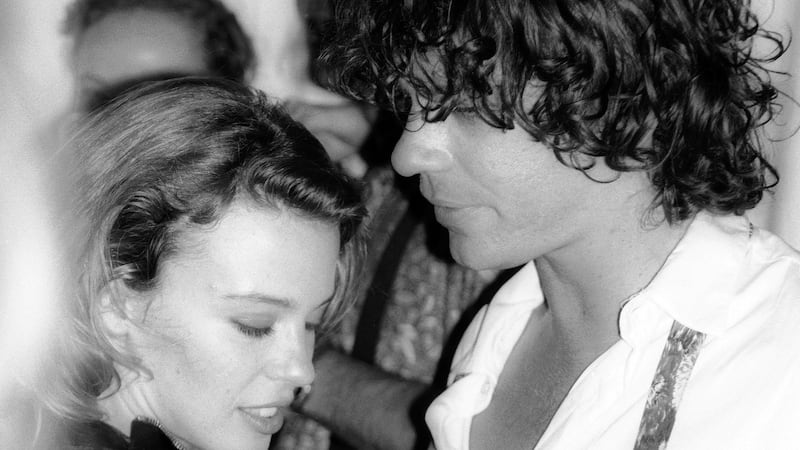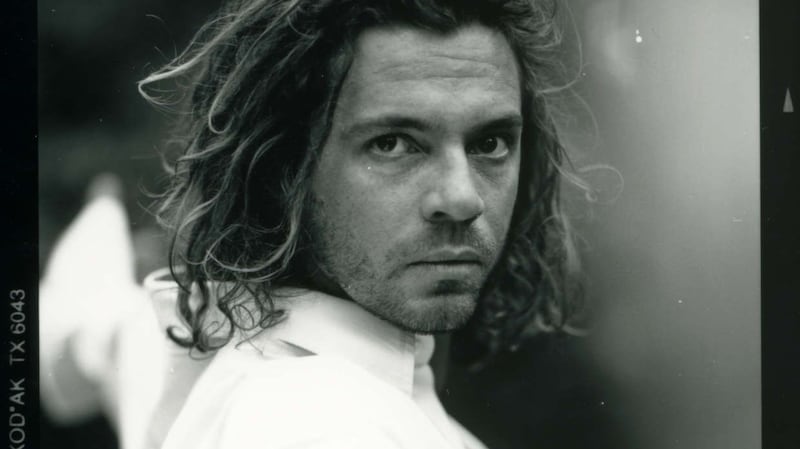The filmmaker Richard Lowenstein remembers the first time he met Michael Hutchence. It was 1984 and the director was, as he puts it, “a pale, lemon-sucking Melbourne punk” when he went to shoot his award-winning video for Burn For You with INXS.
“Michael was sitting around the pool in board shorts,” says Lowenstein. “We’d heard of INXS; they were rising stars. We were goths sweating under our makeup. And he broke through all our bullshit really. Twenty-four hours later we were all together snorkelling off the Barrier Reef. And let me tell you: Melbourne punks don’t snorkel.”
Lowenstein and Hutchence would remain friends and collaborators until the singer’s death in 1997. They would make some 15 music videos together, including the promos for Need You Tonight, Never Tear Us Apart, and New Sensation, as well as the cult 1986 film Dogs in Space. The film-maker even egged Hutchence on to make the first call to Kylie Minogue.
“I remember being in New York with him and this after the success of Kick,” recalls Lowenstein. “He was in the recording studio and going: I think I should ring her. He had a phone number because they had met at a party. But he was saying: she won’t know who I am; she won’t remember. And I said: you’ve just been number one in America; pick up the phone and call the bloody girl! So there was a weird contradiction between what he was like onstage with the long hair and the Jim Morrison swagger and the shy boy that he was.”
More than 20 years have passed since Michael Hutchence was found dead in a Sydney hotel room. The INXS frontman had been embroiled in a custody battle between his partner, Paula Yates, and her ex-husband, Bob Geldof, over their three children.
Alcohol and drugs
A coroner found Hutchence killed himself while depressed and under the influence of alcohol and drugs. Writing in 2017 on what would have been late star’s 57th birthday, his brother Rhett suggested: “Michael may have passed due to lack of oxygen, due to sexual misadventure, or Michael was killed. In the last 19 years, looking, searching, talking to people, I have found all three things to be plausible, but I still don’t have a solid answer.”
Paula Yates originated the notion that Hutchence fell victim to autoerotic asphyxia. This view was supported by the testimony of Prof Stephen Hucker, an expert in the field of autoerotic asphyxiation, in the 1999 Channel 4 documentary In Excess: The Death of Michael Hutchence. Lowenstein’s new documentary, Mystify: Michael Hutchence, takes a very different view.
“I think Paula was afraid that the world would think that he killed himself because he didn’t love her or whatever,” says the director. “But if you speak to any psychologist about suicide, that’s not necessarily the case. The whole autoeroticism theory didn’t actually appear until a few weeks after the funeral.
“The funeral was a bit of a circus but no one mentioned that possibility until a certain interview with Paula happened. And suddenly the press go crazy because here is an easy answer. So he was a naughty rockstar doing naughty things, right out to the end. But if you look at the coroner’s report and look at all the phone calls he was making at the end, it’s a ridiculous theory. He was on the phone to an ex-girlfriend bawling his eyes out and saying I can’t take it anymore 20 minutes earlier. He can’t have gone from that to a sex game.

Sex, love, food, drugs, music, travel, books, you name it, he wanted to experience it
“I spoke to all the girlfriends, off the recorded mic, and I asked if there was there any sign that he liked being strangled or tied up. Everyone says no. I want him to be remembered as the person we portray in the film, not the butt of some comedian’s joke.”
Home videos
Two of those former girlfriends – Kylie Minogue and Helena Christensen – make significant contributions to the documentary. Minogue allowed filmmaker Richard Lowenstein to access private home videos and photographs after he interviewed the singer about her relationship with Hutchence between 1989-1991. She provides touchingly candid testimony.
“Sex, love, food, drugs, music, travel, books, you name it, he wanted to experience it,” she says. “As his partner I got to experience a lot of that as well. If you’re a sensual being, all of your senses need stimulation. He definitely awakened my desire for things in my world. He had insatiable curiosity, all the good things in life and some the bad. He opened up a whole new world for me. A lot of it was based around pleasure, let’s face it.”
In 1991, various tabloid reports had it that Hutchence dumped Minogue over the phone after he began an affair with supermodel Helena Christensen. In fact, Minogue flew from Japan to New York for a dramatic confrontation.
“He was on all fours on the floor crying,” she says. “I didn’t know what to do, I didn’t know what was happening. I just know he was a broken man,” she said. I’d never seen any man like that before. I left pretty confounded and destroyed and knew that was it. He broke my heart. I have to confess that the hurt stayed for quite a long time.”
Altercation
In August 1992, Christensen and Hutchence were out drinking in Copenhagen when an altercation with a taxi driver caused Hutchence to fall backwards and hit his head. He suffered a fractured skull but did not immediately seek medical assistance. The injury left him with an almost complete loss of his sense of smell and a significant loss of taste and increased his levels of aggression and depression.
Speaking about the incident and its aftermath for the first time, Christensen, who was sworn to secrecy by Hutchence, said that he subsequently became “dark and angry”.
“We did a series of music videos right after the accident,” recalls Lowenstein. “Michael arrived in Melbourne and told us straight away that he had this accident. He told us about the loss of taste and smell. But he didn’t tell us about the full repercussions. I remember very clearly talking with my cinematographer Andrew de Groot and saying: something’s not right.
“He was a totally different person than he had been three months earlier. The short temper was very obvious. He was into Thai kickboxing, and if you were talking about something that was frustrating, he’d lash out and put his foot through the plaster of the hotel wall. What was more disturbing for me was his inability to have a coherent conversation. He would start a story, then change tack and talk about something else entirely. I thought there might have been a skull fracture or something, but I never imagined there was what we ended up finding 30 years later.”
Brain injuries
A postmortem examination included in the new film reveals that Hutchence’s brain injuries were far more extensive than previously thought. The already struggling rock star was further compromised when his affair with Paula Yates, who was then married to Boomtown Rats singer and Live Aid organiser Bob Geldof, brought much unwanted attention.
An altercation with a photographer was gleefully reported; an appearance in a sarong was captioned: “You Skirty Rat”. A year before his death, at the 1996 Brit Awards, Hutchence presented the Best Video award to Oasis, prompting Noel Gallagher to sneer that “has-beens shouldn’t present awards to gonna-bes”. The knives were out.

There would be some new drama about the custody battle and he'd lash out and kick the walls
“He had a taste of tabloid attention when he was with Kylie,” says Lowenstein. “But that was just, look at Michael and Kylie snogging in the park. He hated that as well but that was nothing. With Paula, the tabloids reared up with their imposed morality because of Bob Geldof’s reputation and Live Aid. I remember our prime minister once touched the queen and the headlines all over the British newspapers were horrified that some Australian should get their paws on her majesty. There was a bit of that going on. Look at these filthy colonials coming in and taking our prize princess. It was so tacky.
“He was someone who wanted to be liked, whether by the crowds he was performing for or the people he loved. And suddenly Fleet Street are out to crucify him at a time when he doesn’t have the words to defend himself.”
The custody battle for Yates’s daughters added to Hutchence’s woes. In the autumn of 1996, months after the birth of their daughter Heavenly Hiraani Tiger Lily, police investigated claims that opium had been found at the London home shared by Yates and Hutchence. It was reported that the family nanny had tipped off the newspapers. (Geldof was awarded custody of Hutchence’s daughter Tiger Lily following Yates’s death in 2000.)
‘Hotel room’
“I saw him around the time of the opium in the box when Paula had to rush back from Australia,” says Lowenstein. “He was stuck in Melbourne and we were hanging out together in a hotel room because he was told not to go out to a nightclub because of the custody battle. It was not that long before the end. And there would be some new drama about the custody battle and he’d lash out and kick the walls. And his analysis of what he was told was not always correct.
“He thought lawyers were trying to take his own daughter away from him. And you’d say: I don’t think that’s right, Michael. And he’d say: you don’t understand – they’ve got these ancient British laws. A lot of it was paranoid conspiracy theory talk at that stage.
“His very close friends would suggest that he should have some sympathy for Bob’s situation. It was reasonable for Bob to be concerned for his daughters. And he’d listen for a while and then he’d lose his temper. I think there were people whispering half-truths. I think he was incredibly confused – he loved Paula and his daughter and Bob’s daughters as well. I think he was hiding a lot of his battles with depression and his own problems with memory.
“Over the years, a lot of us have felt guilty that we didn’t push him more. But Australian males are not known for communication with each other on emotional subjects like depression.”
Mystify: Michael Hutchence is released October 18th











